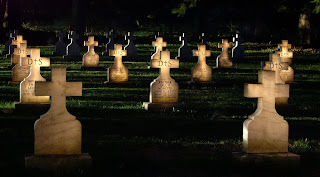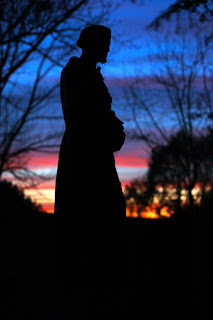One of my favorite things to do is long exposure photography. I love to experiment with all sorts of lighting while the shutter is open, to get lots of great, creative images. I'd like to take some time discussing my approach, and share some of my images with you.
First of all, the exposure settings on the camera itself. Since all of the cameras settings relate to one another (f-stop, I.S.O., and shutter speed), lets see what variables we have to play with, and what setting comes first when shooting in no, or low, light. The given, here, is shutter speed. I like to guess how long it will take for me to illuminate the subject, and then I set the shutter speed to match. This is a starting point only, and sometimes it takes a few changes to get it right.
I often choose the "Bulb" setting, but most often with a film camera; using a shutter release cable. Digital cameras are hard to use with the bulb setting, since they have a push button that closes the shutter back up as you take your finger off of it. I like to open the shutter, and then roam around lighting stuff up with a light. I have used tape and small, peanut shaped objects to overcome this obstacle, so please feel free to be creative.
With the shutter speed close to being correct (allowing time to light the subject) I then go ahead and decide on how I am lighting the subject, and then last, what do I want in focus. The I.S.O. determines how well the digital cameras' sensor reacts to the light. You must ask yourself "what type of light are you using, and how much light are you capturing?". I like to use flashlights quite a bit, so I light up a subject with yet another series of "test images" to get it where I want it.
I.S.O. most often gets set to between a 100 to 400 range. 100 speed gives a nice black background, while 400 "takes" the lighting better. A F-stop of between 8 to 16 should work fine for most situations, but adjust it too match what you are shooting. Keep in mind that the shutter speed is the first adjustment to make, and the most critical. All other settings are adjusted, or follow suit, to the length of the shutter speed.
The three settings are tied into each other, so if I raise the I.S.O. too much, I will need to change the F-stop to match. The depth of field is not too important with dark, nighttime photography, if you are lighting objects with a flashlight. This is because as long as the lit subjects are in focus, nothing else (background and the foreground) will even be seen. So, I use the I.S.O. and then the F-stop at the same time to dial in my light sensitivity, but only after the shutter speed has been set.
I should note that the speed at which you move the beam of light up and down the subject adds brightness or darkness too. Even the strength of the beam itself, and the charge of the batteries can alter the overall brightness. Don't be afraid to alter your cameras settings to taste as you go. This is not a wedding. You can take as long as you like, and "
chimping" is allowed.
 What about long exposure without a direct light source? I like to shoot passing cars on the streets and the interstates. I love the colors and the suggestive nature of movement in the images.
What about long exposure without a direct light source? I like to shoot passing cars on the streets and the interstates. I love the colors and the suggestive nature of movement in the images.
I approach them in much the same way. I get a feel for how long it takes the traffic to move across the frame and then set the shutter speed just a little bit slower that that. Plus, ask yourself how many cars you wish to pass in the frame, as more cars equals more light. Next, I play with the depth of field in my night scene, and set the F-stop to match. Last of all, I shoot some test images in order to dial in the I.S.O. and maybe alter the F-stop too. Make sure that the intensity of the lights on the cars passing by are not too strong or bright in the image, and watch for the background lights that can cause some "road spillage" too. I like some of the light from the traffic to spill onto the road and even light up the signs along the shoulder. But too much spillage of head lights can cause it to look more like daytime instead of the pitch black nighttime.
Have fun
but be careful! Make sure that you can be seen by the passing cars! Please do not "hide" on the side of the road. Sometimes I like to let the local authorities know what I am up to, just to avoid a possible shake down. I pop into the police station and inform the dispatcher of my evenings' plans. That is something I would have never done in my youth.

My favorite, and whom I feel is the true master of this sort of creative energy is
Chris Becker. He has some great ideas, and if you have not yet looked at his images, then you should check out his "
Painting with light" images. The best part about his works are the ideas of subject matter. I like to light every day items too, but he brings a lot of suggestive, provocative energy to the plate.

Remember that running through the image will not alter it, as you can not be "seen" by the sensor. Wearing dark clothing can be of some
benefit too, but not along a roadside. Hold the flashlight so that it can not be "picked up" in the image, but what the light itself falls on will be in the image. I can't tell you how many images I have had to toss out due to either my flashlights tracer being picked up, or the flash display lighting doing the same.
Try using a hard light, versus a soft light. Placing diffusers or make shift snoots onto your light source can add to your technique. Try different types of bulbs too, like a L.E.D. flashlight, or a common battery operated flash light. I like to use a camera flash, held in my hand when lighting large objects. That might need some practice too, as it spills quite a bit.
I mix and match light types and colors too. A nice green or blue can change an images feel and mood. You star trail fans can find ways to keep the shutter open with some easy thinking. Try elastic bands and tiny pebbles, and also Velcro, if tape will not work. I love to set the white balance to the different settings, just to see what colors the different settings will introduce. The sky is the limit!
Please try it out for yourself, and I believe that you will soon be hooked too! Comments and questions welcome, and please subscribe today as I will not go away!
Enjoy!

 The grass in front of the lobster boat was there all along, I was simply trying hard to make sure that it wasn't in any of my images. When I finally bent down to take a look at the boat through the grass and weeds, the finished shot appeared.
The grass in front of the lobster boat was there all along, I was simply trying hard to make sure that it wasn't in any of my images. When I finally bent down to take a look at the boat through the grass and weeds, the finished shot appeared. 

 My favorite, and whom I feel is the true master of this sort of creative energy is
My favorite, and whom I feel is the true master of this sort of creative energy is